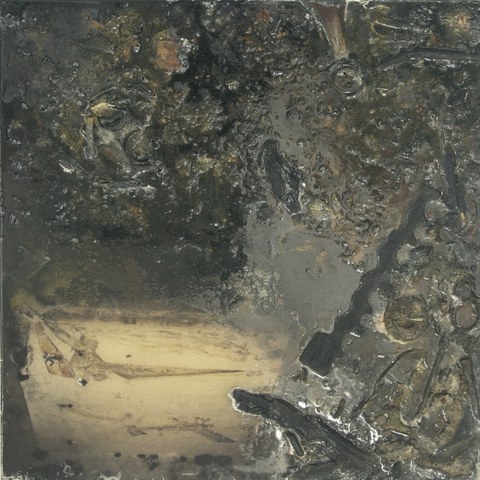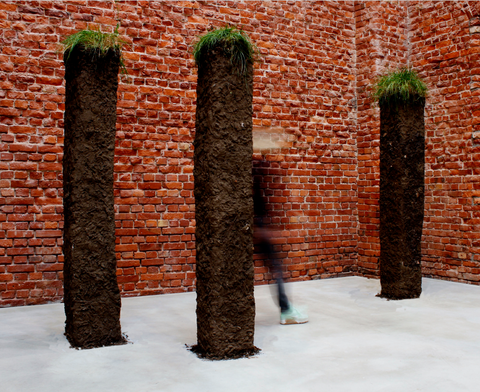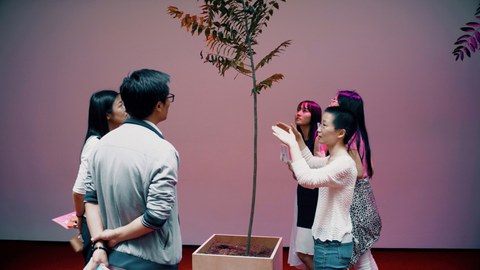Down to Earth: Art and Soil Science in Conversation
Featuring work by Betty Beier, Anne Carnein, Veronika Pfaffinger, Asad Raza
|
An exhibition project by the Office for Academic Heritage, Scientific and Art Collections at the TU Dresden in cooperation with the Institute of Soil Science and Site Ecology, Department of Environmental Sciences (Forest Sciences in Tharandt) at the TU Dresden, the Galerie Ursula Walter, Dresden, and the German Soil Science Society (Deutschen Bodenkundlichen Gesellschaft or DBG). Venues: the Academic Heritage Gallery in the Görges Building at the TU Dresden, Helmholtzstraße 9, 01069 Dresden and the Galerie Ursula Walter, Neustädter Markt 10, 01097 Dresden |
In the 16th century, the genius and polymath Leonardo da Vinci wrote that “we know more about the movement of celestial bodies than we do about the ground beneath our feet.” 500 years later, in the Anthropocene epoch, da Vinci’s assertion is more accurate than ever.
For about forty years, we humans have witnessed the Earth’s response to our attacks and finally its direct reactions to our pursuit of progress, at times as it strikes back. The soil, our basic foundation of life, no longer quietly accepts our unrestrained actions and abuses, but rather rebels and defends itself against these injuries. The global catastrophes caused by climate change and overuse make our interdependency increasingly clear. The effects are apparent in changing ecosystems and landscapes all over the world.
It is the soil itself that is most affected by this unceasing process, determining the appearance of the world and its future both under and over the Earth’s crust.
For this exhibition and teaching project, the renowned contemporary artists Betty Beier (*1965), Anne Carnein (*1982), Veronika Pfaffinger (*1990) and Asad Raza (*1974) were invited to explore the global topic of soil as a natural object and environmental medium. In close cooperation with the Institute of Soil Science and Site Ecology at the TUD, they created works of art especially for the exhibition and its specific spaces.

Bildskulptur „Erdscholle Fahrerbunker“ Digitalprint, Fundstücke aus dem Fahrerbunker, Acryl, Kunstharz auf Sandwich, 100 x 100 x 7 cm, Betty Beier 2008 Abnahmeort: Fahrerbunker, Minstergärten Berlin, 1998 Privatbesitz Berlin
In her “Erdschollenarchiv“” (“Soil Archive”), Betty Beier has documented 30 years of human interference and imprints on landscapes subjected to a constant process of transformation. The artists conserves soil conditions and their changes through human intervention by protecting clumps of earth.
Her artistic practice makes these traces evident through a sort of forensic analysis and simultaneous safeguarding. She captures what climate change and environmental destruction like flooding, deforestation or the human use of landscapes for developmental, military or business purposes leave behind on the upper layers of the Earth and how these forces transform or even damage and destroy the land.
With her fragile fabric installations of plants and roots, Anne Carnein follows in the With her fragile fabric installations of plants and roots, Anne Carnein follows in the image-making footprints of Maria Sybilla Merian and at the same time refers back to early traditions in herb and field guides or herbarium sheets in botanical collections. In her models of these plants, what happens above and most importantly beneath the earth play an equal role. Starting with discarded clothing, fabric remnants and found textiles, she creates delicate sculptures transforming natural objects, which explore the relationship between humans and nature, and the nature of objects themselves. Her work poses questions as ‘memento mori’ within an unconventional and unusual sculptural practice.

Veronika Pfaffinger: Wiesenstücke (2020); diverse Materialien; ca. 40x40x220 cm
Veronika Pfaffinger, together with the soil scientist Prof. Karl-Heinz Feger, has designed an artistic analogy system of fired earthenware for the TUD’s botanical garden, calling attention to the topic of the “Sponge City,” increasing surface impermeability and lack of intact soil. The above-ground “funnels” are an aesthetic experience for casual passersby. They point to the soil ecosystem and its value and capabilities as part of the greater natural ecosystem. They thereby pose central questions about adaptation to climate change (flood vs. drought) within municipal and agricultural planning and give intuitive hints for solutions. The artist has created a companion audio installation at the Galerie Ursula Walter.

Asad Raza: Root sequence. Mother tongue, 2017. Instsallation View The Rockbund Art Museum, Shangai, 2017. Courtesy: The Rockbund Art Museum, Foto: Ray Stonada
To accompany Asad Raza’s projects “Root sequence. Electric Company“ at the university gallery and an installation of neo-soil as well as a current video piece at the Galerie Ursula Walter, a group of “cultivators” or “caretakers” is active at both exhibition spaces. Members of the group interact with visitors, share knowledge about the pieces and take care of the 26 living trees growing in planters and in the ground.
In addition, the exhibition features historic and current objects from the TUD’s teaching collections, the Institute of Soil Science, the Herbarium Dresdense, the historic dye collection, the color research and theory collection and the collections of the Forestry Academy in Tharandt, founded in 1811.
This dialogue at the interface between art and science sensitizes a wider public to the looming and urgent challenges of our Anthropocene epoch and highlights art’s potential to broaden the discourse around sustainability and ecology, making climate policy visible and tangible.
In cooperation with: Green Office, TU Dresden, tuuwi – TU Umweltinitiative
With the kind support of: the Environmental Commission and the Extended University Executive Board of the TU Dresden, the Art and Music for Dresden Foundation (Stiftung Kunst und Musik für Dresden), the Cultural Foundation of Saxony (Kulturstiftung des Freistaates Sachsen), the Arts Commission of Dresden (Kunstkommission der Landeshauptstadt Dresden) as well as the Stadtentwässerung Dresden GmbH (Dresden’s wastewater company).

